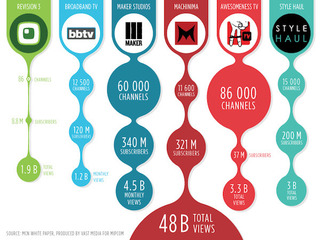Joe Murad, the new CEO of Vida Health, talks about his vision for the company
Murad was appointed last week, succeeding founding CEO Stephanie Tilenius
Read more...

Video is transitioning from an add-on feature to a primary digital communication platform, as production and consumption are still at the earliest stages, though comprising the fastest growing and most visually compelling content produced online.
To wit: just look at the massive shift away from cable toward online streaming services. This shift is also exemplified in services like Facebook Live and Twitter’s Periscope. It was revealed in Q1 that, over the past year, daily watch time for Facebook Live broadcasts has grown by more than four times.
The numbers also bear this out: The average amount of time spent on digital video was almost two hours a day in 2015, up nearly 200% from just over a half hour in 2011. This growth is four times as fast as the 46 percent growth in time spent on social media, which was 104 minutes, up from 71 minutes during the same period. There are now 400 hours of new video shared every minute, and 300 hours of video uploaded to YouTube every minute.
Just as broadband’s adoption rate jumping to 50% in December 2004 was a turning point for the proliferation of online content in general, a similar milestone for video came a decade later when more than half of American households streamed movies and TV shows, surpassing 45 percent of those who watched TV shows live, according to a survey from consulting firm Deloitte. In the same year, video accounted for 70 percent of all broadband traffic.
Yet, despite the dominance of online video, sharing your personal favorite snippets of your favorite movie or show, or drilling into the video to find patterns, is pretty complex and takes time.
Videogram solves this problem. The company indexes online video, looking at subtitles, color and motion, making it easier for people to repurpose or share specific content vs the entire video.
In an interview, Sandeep Casi, Founder and CEO of Videogram, discussed how Videogram enables this, where he sees video opportunities for innovation around video, as well as the origins of the company.
The origins of Videogram
Before founding Videogram, Casi spent nearly 17 years of his career working on media and video, starting at General Motors in the early 90s, working on virtual reality for automotive and crash analysis and design.
From there he went to LucasFilm’s Industrial Light and Magic, adding synthetic and animated objects to natural video, before joining a consulting company, doing digital asset management for broadcasting company, such as CNN and the BBC, helping them transform from analog to digital. His deep experience, earned him a role at Fuji Xerox Palo Alto Labs, and that’s where the idea for Videogram originated.
"The task there was to look at next-generation technologies, to look at how video could actually move away from being more of a passive experience to more of an interactive experience. That's where Videogram was born. It was a team of researchers there that had been working on it, and when I joined they looked to me as someone coming in from the industry who could take the research that had been going on at the Labs and commercialize it," Casi told me.
"Prior to Videogram, video was mostly a very passive affair. You’d sit in front of a movie screen, or a television, and that was basically it. At the end of the content, there was no interaction, and any conversation was done physically, and not in the social realm. The whole point of Videogram was to take video down into the atomic pieces, and then figure out how to reconstruct them, based on a user's preference."
Video bits for learning, identifying
The first attempt to productize the idea was with Fuji Xerox, in Japan, which used it in an e-learning context. At the time, the idea was still research code, called Manga (means Comic in Japanese), and it was eventually turned into a product called MediaDepot, which was sold by Fuji Xerox as a stand alone e-Learning product.
MediaDepot “had none of the bells and whistles that Videogram now has,” Casi explained, including machine learning and Deep Learning, but it was able to take video and chapterize it, allowing workers to skip directly to the parts that they needed to work on. Companies, such as NEC and Fujitsu, used the technology to teach their workforce on different assemblies.
In 2012, Fuji Xerox spun Manga research code out into Videogram (Founded by Sandeep Casi & Rahul Golecha), which soon found that its technology was relevant to a number of real-world applications, such as the construction industry, where everyone is required to wear a hardhat. A company can use Videogram to easily scan its own workplace security videos to see who is not complying.
"We can recognize people as they're going about their business, and see if they're wearing a hardhat or not, and then flag those as a compliance issue. The frames where there is no hardhat get sent to a supervisor for next action," Casi explained. Typically, this hardhat spotting would have to be done manually with a human. Videogram’s technology can do this job faster and cheaper.
Videogram now has 200 enterprise customers, including websites that it feeds traffic back to. That’s the ROI the company brings to companies on the Web; when something is shared on social media, the share returns the user back to the original site, which means the site can better monetize their ad rolls.
So how does it work?
While Videogram is geared toward the enterprise use case, it is also available for the consumer to search and share video as well.
I often find that when I work with video, my stories would be enhanced if I could find a certain video clip my story is referencing. With YouTube, this experience is frustrating, as it’s hard to get very specific, and impossible to find the right moment within a video without watching the whole thing.
One of the ways to search on Videogram is through the dialogue inside of the video. For example, to search for the David After Dentist video, you can search for “Don‘t put fingers in your mouth” and the video shows up at the top of the results.
Or if you want to go right to the point in the Bed Intruder Song video where he says, “Hide your kids, hide your wife!” not only will Videogram bring up the video but it will begin playing it at the moment when that line occurs, making it that much easier and faster to get to the right point in the right video.


You can then share that clip by on social media, plus you can embed into a blog post or an email. The recipient receives the entire video, but the video will start playing closer to the snippet you’ve identified. The entire video is displayed or shared, but viewers and recipients of the video will see the video begin at that specific clip.
It should be noted that this kind of search only works on videos that contain subtitles, though the company says that it is working on speech to text for videos that don’t have them.
"Google crawls the Web, indexes the websites, and then makes it searchable so that it gets easier for the consumer to find what they're looking for," Casi said. "We do a very similar thing with video, which is: we crawl the Web, index it, make it searchable at the scene level, at the object level, and the source is always going to be where that original content is. There are are no issues with rights."
That means that content from Netflix or Amazon Prime, which are closed platforms, won't be showing up on Videogram unless they give it access. According to Casi, there could be benefit to them to opening up at least some of their content to be searchable on Videogram.
"This would be good for Netflix. It's all about creating the funnel to that platform. If Netflix lets us index their videos, the search results for a particular movie or video, that would be the top result, and it would create more traffic to go to their site, and maybe a certain percentage of people might end up being converted into customers,” he said.
“Netflix might allow only users that are Netflix users to complete a search, but the company could also have campaigns running to convert people. Right now they have House of Cards, which is a popular original series. Maybe one or two episodes can be put up for free in order to convert, so the search results would lead you those free episodes. After that, there would be a call to action to buy more."
Editor’s note: Tune in for Part II: Deconstructing video to make it more shareable. In that piece, we’ll look at how Videogram uses its video technology to gamify a viewer’s experience and how Videogram is incorporating machine learning into its technology.
Murad was appointed last week, succeeding founding CEO Stephanie Tilenius
Read more...Noah Medical, which has developed a robotics system for detecting lung cancer, recently raised $150M
Read more...The company just announced a $22.5 million round, bringing its total funding to over $43 million
Read more...Startup/Business
Joined Vator on
Videogram is a HTML5 Social Video Platform.
Videogram automatically analyzes any video file and generates a visually engaging summary with different-sized keyframes arranged in a grid reminiscent of a comic book.
Videogram allows consumers to get a quick overview of an entire video's contents without watching the entire video from beginning to end. Viewers can start – and share – the video from their point of greatest interest, thus eliminating the pain points of streaming / buffering a large video on congested mobile networks.
Videogram is compatible with any video server / player and leaves the original video undisturbed (along with any existing copyright or advertising). And the technology is completely embeddable. Videogram can live on publisher / brand web pages, within apps, or on social networks.

Joined Vator on
Founder & CEO Videogram; Virtual Reality at General Motors, Systems Lead at Industrial Light & Magic(Lucasfilm), Research Scientist at Fuji Xerox Palo Alto lab, Digital Cinema at Fujifilm




